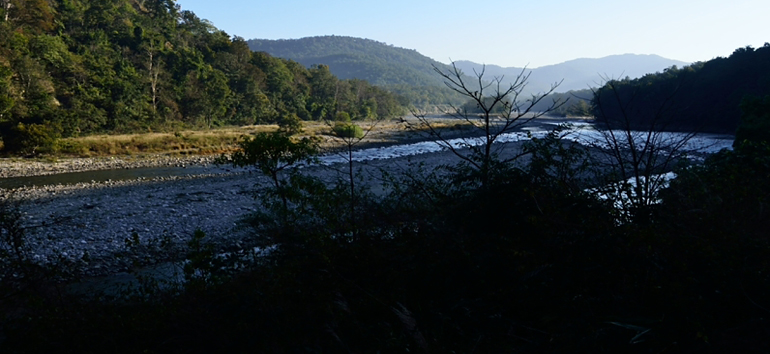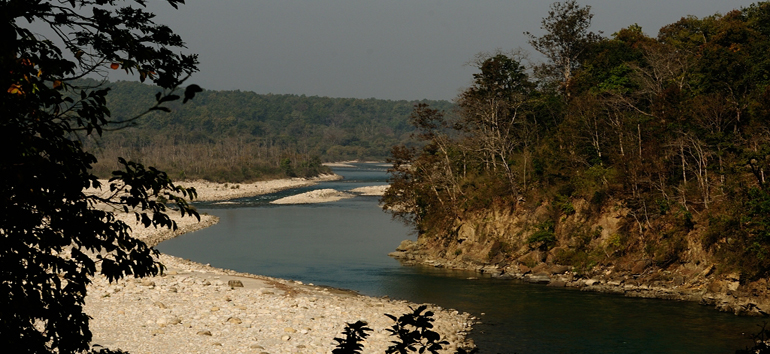Rivers and Around The Park
For Animals lovers and nature enthusiasts, the Corbett national park in Uttarakhand is the perfect holiday destination among the ferocious wild animals along with the serene environment at the foothills of Himalayas. The mesmerizing landscape, the exotic wildlife has made it the popular haunts amongst the tourists from all across the globe. Water is essential for the survival of wildlife and the Jim Corbett national park fulfills this requirement of the animals. There are various hydrological sources in and around the park. Ramganga is a major river flows and the most important source of water along with the kosi and the sonanadi. They keep the aquatic life of the region alive and active. The major rivers flowing through the park are-

Ramganga River:
The largest amongst all the water bodies of the park, one cannot imagine the existence of the reserve without the presence of this river. The park was initially named the Ramganga Park in 1954-1955 in honour of this river and later changed to the Corbett national park. It is a rain fed river originating from the dhoodhatali in the lesser Himalayas at a height of 800-900m and flows through the Corbett, near ramnagar in the nainital district. A dam has also been constructed on the Ramganga River at kalagarh in the 1970’s. The reservoir of this dam is near the dhikala zone of the national park.
Aquatic species like masheer fish, endangered gharials, otters, turtles and mugger crocodiles are found in this river. Various species of birds like the kingfisher fish eagles, storks and terns are dependent on this river for their survival. Many migratory birds from central Asia make this river their home during winter months.
Many tourists’ resorts and hotels are constructed on the banks of this river which provide a gleaming view of this river. The road linking dhikala to dhangarhi runs along this river. The watchtower of dhikala in the patli dun valley is the perfect place to observe the river. For a closer and better view of the river, the tourist can get off their vehicles at the crocodile pool, the high bank and the champions’s pool. For a bird’s eye view of the river, the kanda forest rest house is the best place, being the highest rest house of the Corbett national park.

Kosi River:
A perennial river, it flows through the eastern part of the park, from mahan to dhikuli till ramnagar but does not enter the park. The waters of the Kosi River help the animals of the reserve to quench their thirst. Like the Ramganaga River this river is also inhabited by the rare masheer fish and attracts migratory birds in winters. The river bed comprises of boulders and it keeps changing its course. It has an erratic flow and becomes notorious during the monsoon months. Many cliffs can also be seen alongside the river and many a times the tourists spot gorals, which appear like goats grazing on the slopes near the river bank. Numerous aquatic species are found in this river but predominantly the mahseer fish.
Koshi River
The Kosi River flows along the eastern periphery of the park, from Mohan till Ramnagar via Dhikuli. The wild animals of Corbett National Park use the Kosi River to quench their thirst.
The bed of this river is sprinkled with boulders and the flow is unpredictable. The river also changes its course frequently. Similar to Ramganga, the Kosi River is also a preferred habitat of Mahseer fish and the river also entices many migratory bird species. The Kosi River also comprises many sheer cliffs adjoining its banks. In certain pockets of the park, tourists can even encounter gorals, which look somewhat like goats, grazing on the slopes.
Major Aquatic Species: There are several major aquatic species found in the Kosi River. Predominant among them is the Mahseer fish.
Sonanadi River
Named after the sonanadi wildlife sanctuary which adjoins the Corbett national park, this magnificent river is a tributary of the Ramganga River. It is an important river of the Corbett reserve and enters the park from the north western corner and greets the Ramganga River near the reservoir. Sonanadi means river of gold. At earlier times, grains of gold were extracted from the alluvium deposits of the river through sieving, washing and mercury treatment which were washed down from the higher areas.
Mandal and Palain
It forms the north eastern border of this park. This particular river originates from the talla salan in the district of Chamoli. After flowing for 32kms, it bumps into the ramganga at domunda above gairal. It provides an important ground for the mahseer fish. A gentle and controllable water body in the summer months, it gets extremely energetic and in the monsoon months. Palain reaches the Ramganga River and comes into the reserve from the northern part. It joins the Ranganga River 3kms north of the boxer settlement of the ramganga reservoir.
Sots
They are seasonal streams which are found in and around the reserve. They are an important source of water for the animals during the dry months to quench their thirst. Although dry and lifeless, they are important for the ecological balance of the park. Some sots like jhirna, garjia, paterpani, dhara, kothirao and laldhang are perennial, they are of vital importance since water is a major problem and they help to overcome this problem, particularly for the wildlife during the pinch times of the year.
These sots become problematic during the rainy season, since they overflow and wash away the roads and temporary bridges. Due to this the Corbett National Park is closed during the rainy season since these roads and bridges need to be repaired, after every monsoon, by the forest department. Most f these sots are covered with shrubs and bamboo clumps, providing an ideal shelter and habitat for the wild animals including the giant cats. They also act as a passageway for the animals.
The water bodies of the Corbett national park are very important for maintaining the ecological equilibrium of the area and preserving the balance of nature for the future generations. Apart from this the rivers offer adventure activities and sports to the tourists. Fishing and angling is very common in the rivers of the national park, the only requirement being a permit for the same. It is one of the best places for fishing in India and records some of the biggest catches. Corbett provides the travelers the experience of mahseer fishing since they are found in abundance in the water bodies of this reserve.
Surrounded by dense forests, with a captivating view of the Himalayas, the rivers in and around the park add to the enchantment of the place and is a treat for the wildlife admirers and lovers.